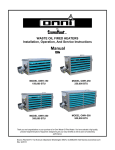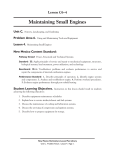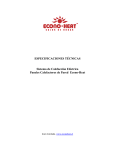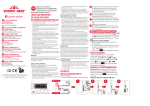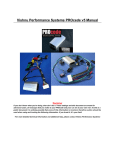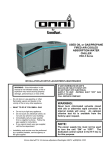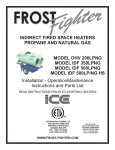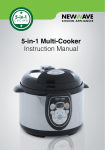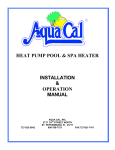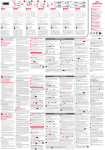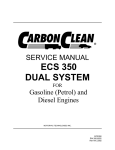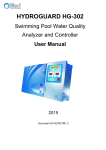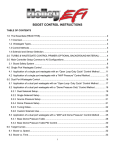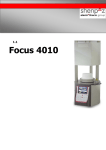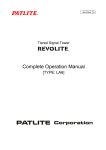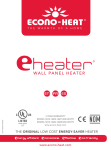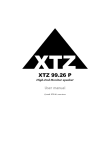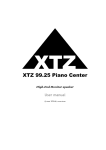Download Heater User Manual (all Models)
Transcript
By WASTE OIL FIRED HEATERS Installation, Operation, And Service Instructions Manual MODEL OWH-150 150,000 BTU MODEL OWH-250 250,000 BTU MODEL OWH-350 350,000 BTU MODEL OWH-500 500,000 BTU Thank you and congratulations on your purchase of an Omni Waste Oil Fired Heater. You have selected a high quality, precision-engineered piece of equipment, designed to give you many benefits as well as years of outstanding performance. Econo Heat♦5714 1st Avenue♦Spokane Washington 99212.♦(509)534-1022♦www.econoheat.com 100267 Rev A3 PRECAUTIONS Waste oil may contain many foreign materials. Waste oil may also contain gasoline. Therefore, specific precautions on the handling and storage of waste oils are to be observed when using, cleaning and maintaining this heater. Use a screen in a funnel when pouring oil into storage tank to catch foreign material, i.e., gasket material and sealant fibers, etc. WARNING: This appliance is not designated for use in hazardous atmospheres containing flammable vapors or combustible dust, or atmospheres containing chlorinated or halogenated hydrocarbons. Do not expose this unit to rain or moisture. If installed in high moisture atmosphere, a special cover for the integrated air compressor must be obtained from factory to avoid rusting of internal raw metals. If this occurs, see trouble-shooting guide for remedy. Uses only crank case oil, gear oil, hydraulic oils, auto trans. Fluid or #1 and #2 furnace oil. Do not use old, contaminated oils that have been stored in underground tanks or outside barrels for long periods. Excessive water and sludge may be present, causing quick filter plugging. NOTES: The instructions contained in this manual apply to the installation, operation, and service of Omni Waste oil fired heaters. The following instructions should be carefully followed for obtaining the best possible installation, operation and service conditions. Specifications are subject to change without notice. This heater was designed to be a primary or auxiliary heat source, but not the only source of heat. And provide economical disposal of waste oil. Proper operation depends on the consistency of the oil. Any water or foreign material in the oil may cause the unit to shut down. If a continuous stream of oil cannot be guaranteed at the heater, the main heating system should be set above freezing which will prevent any building damage if the waste oil heater were to become inoperative during subfreezing weather, i.e. supply tank empty, filter plugged, etc. UNCRATING: Immediately upon uncrating units, check rating plate for certainty of electrical and mechanical characteristics. Also check the unit for any damage that may have been incurred in shipment, if any damage is found, file a claim with the transporting agency. The unit has been tested and inspected at the factory prior to crating and was in perfect condition at that time. If anything is missing check packing slip for indications of possible backorder of those parts or components. Otherwise a claim must be filed for those missing parts. 2 Installation, Operation, And Service Instructions IMPORTANT NOTICE TO OWNER AND INSTALLER To enjoy the long term benefits of burning your used oil in an Omni Waste Oil Burning appliance, it is necessary to become familiar with the correct installation operation and maintenance of your new furnace. Before installing or operating this appliance, make sure you read and understand this manual. IMPROPER INSTALLATION OR LACK OF MAINTENANCE WILL VOID THE WARRANTY The most critical sections of this manual are in order of importance as follows: • • • • Basic Operation Knowledge Oil Suction Line Installation Correct Draft Over Fire General Maintenance Requirements Identical to any gas or oil furnace, without adequate draft over the fire, the combustion gases cannot escape the furnaces. The flame will lengthen resulting in an overheated combustion chamber. Even if the heater is installed correctly and adequate draft achieved, a flue passage blockage will affect the draft. Burning used oil is similar to burning wood. A fine gray ash accumulates in the chamber and flue passage. This accumulation of ash will eventually affect the draft. It is important to remove this ash before the draft is affected. These topics are discussed in detail on the pages listed above. Please familiarize yourself with these sections of your manual. Spending a few minutes to review this material will assure that you receive the return on investment that you expect from your Omni heater. Installation, Operation, And Service Instructions 3 SPECIFICATIONS MODEL BTU’S/HR INPUT BTU’S/HR OUTPUT GALLONS PER HOUR VOLTAGE REQUIREMENTS AMPS FULL LOAD with Pump FAN MOTOR HP FAN MOTOR RPM FAN DIA/PITCH OWH-150 150,000 120,000 1.0 115 14.6 OWH-250 250,000 215,000 1.75 115 17.0 OWH-350 350,000 300,000 2.4 115 18.7 OWH-500 500,000 410,000 3.4 115 23.5 1/4 1075 18/36 1/3 1075 24/18 2 @ 1/4 each 1075 18/36 2 @ 1/3 each 1075 24/18 CFM (FREE AIR) CFM W/ DUCTWORK at 100 FT EFFECTIVE AIR FLOW FLUE SIZE WEIGHT W/ BURNER SHIPPING WEIGHT DIMENSIONS L/W/H SHIPPING DIMENSIONS L/W/H 3762 380 4466 2000 6275 1600 9001 3701 50 FT 8” 240 LBS 375 LBS 42-22-25 ½ 64 ½-30-49 60 FT 8” 365 LBS 535 LBS 44-30-28 ½ 64 ½-39-49 70 FT 8” 400 LBS 575 LBS 54-29 ½-28 ½ 76-38-49 100 FT 10” 660 LBS 725 LBS 72-38-34 ½ 92-44-50 Notes: 1. 2. 3. 4. 5. 6. 7. All illustrations and specifications contained herein are based on the latest information available at the time of publication approval. Econo Heat reserves the right to make changes at any time without notice, in materials, specifications, and models or to discontinue models. These appliances are designed for commercial or industrial use only. Installation and use of this waste-oil burning appliance shall be in accordance with the Standard for the Installation of Oil Burning Equipment-ANS/NFPA 31-1987, and National Electric Code ANSI/NFPA 70-1990 and the requirements of the inspection authorities having jurisdiction. Output depends on BTU content of oil used. Atomizing Air Pressure for all fuels 10 P.S.I. Furnace not to be used with air filters. Intended maximum outlet air temp. 200 degrees F. (93 degrees C) or less. Clearance from combustible materials on all models not to be less than: TOP- 6” REAR- 18” BOTTOM- 18” FRONT- 48” SIDES- 18” FLUE PIPE- 18” Mounting Dimensions: MODEL 4 A B OWH-150 35 ½” 20” OWH-250 35 ½” 22 ¼” OWH-350 47 ¾” 22 ¼” OWH-500 63 ¼” 28 ¾” Heater (Top) B A Installation, Operation, And Service Instructions INSTALLATION PROCEDURES Class A Pipe 1 2' minimum higher than any portion of a building within 10' 3' minimum above the highest point where it passes through the roof of a building. 10' Roof Jack Supporting Thimble Barometric Damper 2 3 4 Heater Thermostat Circuit Protection Box 5 6 Oil Pump With Serviceable Strainer Filter Oil Supply Tank 7 1 Class A Pipe, 8" or 10" stack depending on heater model (check local codes) 2 3 4 - 1/2" all thread hangers. Heater must be mounted level to allow standard 3% downward burner pitch into combustion chamber. 115vac 20amp power source. Wire and conduit per local codes. 4 Low voltage thermostat wire to "T" terminals of oil primary control on burner. 5 Oil suction line, 3/8" ID copper tubing. 6 Oil feed line, 3/8" ID to bulkhead connector on heater cabinet. 7 Suction line 6" minimum from bottom of supply tank to prevent sludge from being introduced into the supply line. Figure 1 – Installation Diagram STACK INSTALLATION 1. (Optional) Install the supplied barometric damper in stack if draft up stack exceeds -.08. Draft up stack must be -.04 to -.06 inches of water column. Check with draft meter between the top of heater and damper. The over fire draft should be a minimum of -.02- check through flame inspection port. Closing the damper door can increase draft. Installation, Operation, And Service Instructions 5 2. For optional draft inducers or power vent wiring, See Figure 2. One of these devices must be installed where back draft is present. In building or correct draft cannot be achieved. OIL SUPPLY PIPING 1. Use ONLY 3/8” nominal ID copper tubing with flare fittings only on the fuel suction from the tank to the heater- Do NOT use ferrule fittings or Teflon tape on any pipe fittings. 2. Keep suction line approximately 6” from bottom of oil tank to prevent suction of sludge. Drain accumulated sludge and water from tank periodically. 3. Use only an inside oil storage tank to supply heater. Do not draw from an outside tank, especially not an underground tank, directly to heater. A separate transfer pump from an outside tank with proper filtration to the inside supply tank is acceptable and available from Econo Heat. 4. The fuel supply pump included with heater is to be mounted at tank level or below. (figure 1). This pump turns slowly requiring a number of minutes to accomplish purging ALL air, if bubbles, skips, even slight pulsations in the oil flow from pumps bleeder port is unacceptable and must be removed assuring proper oil flow to heater. Otherwise the flame sensor will not see enough flame and heater will lockout. NOTE: PUMP ASSEMBLY MUST BE MOUNTED HORIZONTAL. 5. Connect 3/8” oil supply line from the supply tank through the filter (figure 1) to the pump inlet located same side as bleeder port. (figure 6) Continue oil supply line from pump outlet to bulk head fitting secured to cabinet at left side of burner assembly (bulk head fitting has fuel flex hose connecting it to burner). WIRING See Schematic diagram below and/or inside door of main electrical junction box on heater. 6 Installation, Operation, And Service Instructions FUEL TRANSFER PUMP Fuse Power Switch THERMOCOUPLE HIGH VOLTAGE TRANSFORMER OIL PREHEATER BLOCK L2 L1 WHT BLK CABINET FAN MOTOR BLK ORN BLK WHT WHT RED BLU YEL BLOWER MOTOR OIL PRIMARY CONTROL (IE, Honeywell, etc.) O OPTIONAL TIMER RELAY BLK ORN WHT L1 BLK WHT Bi METAL HIGH LIMIT SWITCH JUNCTION BOX BLK WHT BLK YEL WHT BLK BLU RED RED WHT WHT GRN WHT RED BURNER DOOR SAFETY RECEPTICLE WHT 500W HEAT ROD AC POWER INPUT L2 PRI L2 L1 HTR BURNER DOOR SAFETY PLUG (See Fuel Pump Schematic Under Pump Motor Cover or User Manual) L1 WHT YEL OIL PREHEATER BLOCK CONTROLLER RED M W L2 HIGH LIMIT & FAN SWITCH CABINET THERMOSTAT CONNECTION OPTIONAL DRAFT INDUCER MOTOR PHOTO EYE FLAME SENSOR BURNER Figure 2 – Wiring Diagram 1. Wire 120V into main electrical box mounted on burner backside of heater cabinet with separate circuit 20-amp protection using 12-gauge wire. Connect power line to black wire and all whites (NUETRAL or COMMON) together. IMPORTANT, Connect ground wire to ground mounting point in main junction box (green screw). 2. Connect wires from main junction box to remote oil pump power. Yellow to yellow and neutral common white to white. 3. Wire low voltage thermostat into “T” marked terminals on oil primary control on burner. (Box on burner gun assembly with red reset button). (figure 3). DUCTING All unit heaters are designed with a condenser-type pressure propeller fan for air deliver, and have been successfully field ducted. (See Specifications) call factory for further assistance if needed. OIL BURNER WARNING Installation and use of this used oil burning appliance shall be in accordance with the standard for the Installation of Oil Burning Equipment – ANSI/NFPA 31 – 1987, and National Electric Code – ANSI/NFPA 70 – 1990 and the requirements of the inspection authorities having jurisdiction. Installation, Operation, And Service Instructions 7 Oil Primary Control Igniter Transformer Air Pressure Adjuster Air Band (Combustion Air Supply Adjustment) Air Compressor Run Indicator Power Indicator Oil Pressure Gauge Air Pressure Gauge Figure 3 – Oil Burner (Back View Closed) Pre-Heater Control Circuit Board Oil Pre-Heater Block Air Muffler/Filter Photo Eye Flame Sensor Transformer Igniter Springs Electrical Terminal Block Heater Electrical Schematic Figure 4 – Oil Burner (Back View Opened) 8 Installation, Operation, And Service Instructions Electrodes Oil Valve Nozzle Burner Motor Flame Cone Figure 5 – Oil Burner (Front View) Oil Outlet Oil Inlet Figure 6 –Oil Pump Diagram Installation, Operation, And Service Instructions 9 Oil Pressure Gauge- Bench mark indicator for proper flame length adjustment and filter pump screen or valve cleaning requirements Cleanable Strainer Oil Filter- removal of one nut for screen access Oil Primer Switch Oil Shut-off ValveEliminates start delays due to possible drain back Inline Breaker Adjustable Motor Speed- Initial set up only- Once set, no adjustment needed thereafter Oil Flow Control Supply Pump has the ability to control flame even when various viscosities are used- furnace or stove oil to 90 weight straight- flame remains stable Figure 7 –Oil Pump Assembly OIL BURNER TECHNOLOGY Atomization Through Low Pressure Preheat & Air Induction At Nozzle Oil Preheater Inside Burner Suction Line Pressure Line Air Line to Preheater Mixes with Oil at Nozzle Air Compressor On Burner Oil Tank Air Filter Flow Control Oil Pump Internal Pump Filter Filter Omni’s patented burner technology improves the efficiency of the oil burn process by continuous stabilization of the oil viscosity. Optimum atomization (spray) is accomplished by precisely preheating the oil and air prior to introduction to the combustion chamber. The waste oil enters into the Oil Pre-Heater Block (figure 4) and is pre-heated to operating thermo setpoint, then 10 Installation, Operation, And Service Instructions compressed air from the air compressor (figure 3) is mixed with the oil prior to spraying out the nozzle similar to fuel injection, by breaking up the oil droplets into a finer mist or spray (atomization). Electrodes mounted just above the nozzle (figure 5) provides continuous electrical arc across electrode to electrode igniting the fine oil mist as it sprays out of the nozzle. Once ignited the flame is forced into a swirl caused by the burners blower and specially designed flame cone (figure 5) providing a very efficient and thorough burn of the waste oil. Burner Components • Igniter Transformer: (figure 3) Supplies high voltage to the electrodes generating electrical arc igniting the oil. • Oil Valve: (figure 5) energizes when burner is running and de-energizes when burner is not running eliminating bleed back of oil out of the Pre-heater block. • Air Band: (figure 3) Adjusts amount of air introduced into the combustion chamber. Air band is adjusted at the factory for optimum performance, approx. ½ to ¾ inch open. NO FIELD ADJUSTMENT REQUIRED unless in high altitudes application where minor adjustment may be required. • Oil Primary Control: (figure 3) Controls the oil burner ignition. Checks for flame in the combustion chamber, if no flame is detected within 45 seconds, the oil primary will shutdown the oil burner. To restart the unit, reset the red button on the oil primary. • Oil Pre-Heater Block: (figure 4) Pre-heats the oil and air before entering combustion chamber. • Photo Eye: (figure 4) Senses flame in combustion chamber and signals oil primary when no flame is present. • Igniter Springs: (figure 4) Transfers the high voltage from the igniter transformer to the electrodes (when door is closed) • Air Pressure Gauge: (figure 3) Displays air pressure supplied by onboard air compressor. • Air Compressor: (figure 3) Supplies air used within pre-heater block to aid in atomization of the oil. • Air Muffler/Filter: (figure 4) Filters air and muffles the sound generated by the compressor. • Pre-Heater Control Circuit Board: (figure 4) Precisely controls temperature of the Oil Pre-Heater Block and controls safety feature of not allowing burner to energize until oil has established operating thermo setpoint or shutdown burner if Pre-Heater Block temperature falls below shutdown thermo setpoint. • Electrodes: (figure 5) Provides continuous high voltage electrical arc from electrode to electrode igniting the waste oil as it is being sprayed out of the nozzle. • Nozzle: (figure 5) Low pressure nozzle for oil spray pattern. • Flame Cone: (figure 5) Specially engineered flame cone forces the flame into a swirl pattern improving the burn thoroughness. • Burner Motor: (figure 5) Multitask motor turns the burner blower and integrated air compressor. • Air Pressure Adjuster: (figure 3) Adjusts the air pressure going to the pre-heater block. Should be adjusted between 12 PSI and 13PSI as indicated on the Air Pressure Gauge on the burner for thorough burn of the waste oil. Installation, Operation, And Service Instructions 11 Note: In order to insure proper air adjustment, air gauge must read 0 when burner is cycled off or powered down. • Oil Pressure Gauge: (figure 3) Displays oil pressure at the burner. Adjust flame length in the heater combustion chamber viewed through the inspection port located directly above the burner gun assembly by increasing CW or decreasing CCW the adjuster located on the oil delivery pump (figure7). The adjuster increases or decreases the pump motors RPM which increases or decreases the delivery of fuel to the burner. When you increase or decrease the fuel to the burner you will notice the flame length will increase or decrease. Adjust flame length so flame is just slightly less than halfway down main combustion chamber tube. IMPORTANT: Once adjusted for correct flame length, take note of oil gauge setting for bench mark pressure reading needed when burning the specific fuel mixture generated by the owner. PLEASE NOTE- Once flame is set the oil pressure gauge can read various pressures when different viscosities of oils are used. The oil pressure gauge is an indicator of where the PSI reading will be when that oil viscosity is being burned. The oil gauge is used for servicing diagnostics assistance. 12 • Power Indicator: (figure 3) Indicates when power is present at the burner. • Run Indicator: (figure 3) Indicates that the burner is ready for operation after the initial pre-heat time of approx. 5 minutes from initial power up. Installation, Operation, And Service Instructions INITIAL START PROCEDURE 1. IMPORTANT- Prior to starting the unit, pre-fill the filter and fuel line with oil to assist priming procedure. Oil pump motor turns at low RPM’s and would take significant time to complete priming process if not pre-filled. Make sure the oil supply line fittings are air tight. Vacuum leaks are notoriously hard to find. Pressurizing the line with oil in it can help to locate leaks. 2. Proper draft. Draft is the gasses traveling through the heater and out the stack or flue. If exhaust fans are present in your building, chances are a draft inducer will be needed. Call our factory or see our website for help, www.econoheat.com 3. During the initial power up process the burner is locked out from energizing until the oil has been properly pre-heated to operating thermo setpoint, approx 3 to 5 minute duration. Once the oil has been pre-heated, power is then applied to burner componenets and oil pump. 4. Making sure the thermostat is turned off, apply power to the burner. Switch burner main power switch to ON position. After allowing the oil pre-heater time to establish temperature setpoint, approximately 5 minutes. Jump the “T” terminals on the Oil Primary Control (figure 3). Once the burner is running, temporarily jump the “F” terminals on the Oil Primary. This will allow the burner to run during the pump priming process. 5. Priming the oil pump: Open bleeder valve one turn until all air is expelled (figure 6). This may need to be done twice to insure all air is removed. IMPORTANT: When fully purged and flame is established remove temporarily jumpers on “F” terminals of the Oil Primary to allow safety features of the unit to operate properly. 6. Adjust air supply of integrated air compressor to 8-12 P.S.I. This is factory preset, however, due to freight handling settings may be compromised. 7. Combustion air band (figure 3) should be open approximately 1/2” or until flame is clear yellow, not orange. Opening the air band too far may cause delayed in starting or even prevent the flame from starting. 8. Inspect flame length through inspection door located above burner gun assembly. End of flame should reach no further than ½ way down combustion tube. To accomplish this flame length, use adjustment knob on opposite side of oil pump. NEVER ATTEMPT TO START HEATER WHEN COMBUSTION CHAMBER IS HOT AND A DELAYED START OCCURS. MAINTENANCE SCHEDULE WEEKLY --- Drain water from storage tank. MONTHLY --- clean stainless filter screen in filter periodically and drain off any water accumulation (figure 14). Monitor : every application is different and may vary depending on contamination of oils being used. ONCE EACH SEASON (OR MORE DEPENDING UPON USAGE OR CONTAMINATION OF OIL). --- Swing out burner assembly door and clean flame cone. (figure 5 and figure 8). --- Remove combustion chamber & heat exchanger clean out panels at same side of lift out door panel on heater and vacuum out the accumulated ash & soot. (figure 12). --- Clean pump strainer. Remove pump cover for access. (figure 13). CAUTION!-Be careful of gasket. --- Clean air compressor filter element. Installation, Operation, And Service Instructions 13 YEARLY --- Clean flue pipe stack-to loosen soot remove stack at top of heater and tap thoroughly. Then vacuum upper exchanger. --- Inspect electrode adjustment. (figure 10). Due to erosion, adjustment may change. --- Replace nozzle every 3-5 years depending on usage (figure 5, 9, 11). Will lose efficiency due to erosion. This can be accessed by swinging burner door open. (figure 8) ---IMPORTANT: TO TURN POWER OFF, Remove electrical plug from heater cabinet to burner. Remove 9/16” burner door securing nut, swing open burner door. Remove nozzle with 5/8” socket. (figure 8, 9) ELECTRODE ADJUSTMENTS Electrodes are adjusted at time of manufacture. However, they should be check periodically and at time of installation to be sure they are set as noted in the following dimensional drawing. Swing burner door back for inspection. (figure 5, 10, 11) CAUTION: TURN OFF MAIN ELECTRIC SUPPLY SWITCH BEFORE CHECKING OR ADJUSTING ELECTRODE SETTING. NOZZLE POSITION IN RELATION TO ENDCONE/BURNER TUBE Tip of nozzle must be ¼” ahead of inside radius of end-cone. If nozzle is behind inside radius of end-cone, coking will occur and end cone can become clogged. (figure 10). IMPORTANT NOTE: be sure nozzle is centered, if nozzle is higher than center, press nozzle down to bottom out preheater stand. To adjust, open burner door (figure 8), loosen Preheat Sink securing nut and set screw, push fore or aft as needed. WARNING: This adjustment is done at the factory and should not be moved unless Fig 8 dimensions have been altered. When cleaning, inspect all three pieces thoroughly. When disassembling and reassembling nozzle, keep facing up as shown. Figure 8 – Burner Door View 14 Figure 9 – Nozzle Assembly Detail Installation, Operation, And Service Instructions Figure 10 – Electrode Adjustment Detail Electrodes Nozzle Pre-Heater Control Card Thermocouple Figure 11 – Pre-Heater Block Detail (Removed From Burner for Clarity) Figure 12 – Combustion Chamber and Heat Exchanger Cleanout Door, Models OWH 250, 350, 500 Installation, Operation, And Service Instructions 15 Remove 4 bolts for access to strainer. CAUTION must be taken not to destroy gasket during removal of housing Tabs Strainer must be installed with tabs in direction shown Figure 13 – Pump Strainer Washer Nut Bolt Filter Housing Filter Housing Stainless Filter Screen Figure 14 – Oil Filter 16 Installation, Operation, And Service Instructions TROUBLE SHOOTING ♦Most Likely Symptom 1. Heater shuts off 2. Loss of prime overnight •Less Likely Cause ♣Least Likely Remedy ♦Manual reset ♦Requiring manual restart by reset button on. ♦Vacuum air leak in fuel line ♦Check all fuel connections. Tighten fittings. Won’t hold vacuum ♣Plugged pump screen ♣ Check pump screen, may need cleaning-to access, remove pump IS TANK EMPTY? • Plugged filter or tank oil empty • Clean filter. Using vent port, reprime pump (See Figure 6 & 7). ♦Vacuum Leak ♦Open bleeder port if air present. Check and tighten fittings. ♦Inadequate Fuel Supply ♦Clean filter. Check all fuel connections. Tighten fittings. • No Pressure • Check, may need cleaning—to access, remove pump cover. cover 3. Fails to start. • Using vent port, reprime pump (See Figure 6 & 7) •No Pre-heat • Be sure all wiring to pre-heater is tight-no loose connections. •Auto start circuit not functioning • Check circuit control board and replace if necessary.(Call Factory) • Bad firerod-Replace. Continuity at terminals. • Check continuity at terminals of firerod limit snap switch. •No Arc Replace if needed. • Check springs to electrode rod adjustment (under transformer) make sure they make good contact. Open burner door and make sure electrode tips aren’t touching flame cone. Readjust. •No Air Pressure • Check pressure regulator and adjust. Check air supply line for restrictions or leaks. Pull compressor cover and inspect carbon vanes. May need to replace. Check filter, clean if needed. 4. Reduced air pressure, cannot increase. ♦Gauge may be bad. ♦Replace gauge. ♦Intake filter muffler is plugged ♦ Remove & Clean with carburetor cleaner, ♣Compressor vanes may be worn. ♣ Replace carbon canes. with dust or dirt. • Exposed to water. 5. Hard starting diminished flame. dry thoroughly. Do Not Use. • Remove cover, clean rust with emery cloth. ♦Partially plugged filter. ♦Clean filter. Using vent port-reprime pump (See Figure 6 & 7) ♣Out of fuel ♣Refill Storage. ♣No oil to burner ♣Clean pump screen-Remove pump cover. Using vent •Restriction in nozzle usually only •Remove nozzle and check for foreign objects. (See Figure 9 and 11) •Aluminum Block Pre-heater inside burner should not build port, reprime pump. (See figure 6 & 7) when initially installed. New lines may have foreign material in them. up carbon. If carbon is present, pre-heat circuit is malfunctioning. Thermocouple heat sensor wire could have open circuit. Heat control board may have blown circuit and circuit board fuse. Inspect both and replace either if needed. (See Figure 11). •Air band open too far •Close air band—while viewing flame; open air band ♦Heater over firing. ♦Investigate and locate reason for over firing. I.e., nozzle slowly until combustion chamber is clear, not orange. 6. Heater cycles frequently, without thermostat eroded, pump not functioning properly, decrease pump motor speed. temperature setting being achieved in area to be heated. ♣Temperature setting wrong On high limit fan safety switch. •High limit safety switch bad Installation, Operation, And Service Instructions (See #6 for remedy) ♣Check temperature setting and adjust as necessary. • Replace high limit fan safety switch. 17 7. Heater rumbles and ♦Pump setting wrong excessive heat blow back ♦Pump not functioning properly-over firing. May need RPM readjust. Reset flame slightly less than ½ way down tube from flame vision port. combustion chamber. Use adjustment knob on pump motor. (See Figure 7). ♣Draft incorrect. If proper draft can’t be achieved, heater could ♣Set draft. Clean out combustion chamber and exchangers of ash. Check draft-reset if needed. have excessive amount of ash and wont allow sufficient draft. 8. Heater establishes flame but locks out or shuts off. Need to reset primary. 9. Proper draft setting cannot be achieved ♦Photo eye cant see flame. ♦Clean photo eye which is smoked up by back draft smoke. ♣Due to back draft. Flame end ♣Swing open burner door and clean ash build up from flame cone may have ash. end cone. (See Figure 5 & 8). •Flame too small •Increase pump motor speed (See Figure 7). ♦Negative draft in building ♦ May need to install power vent/draft inducer’s in stack. ♣ Excessive ash buildup/Heater ♣ Clean ash and soot from combustion chamber and heat or exhaust fans present. (See Figure 2 for wiring). exchangers. 10. Poor or reduced heat production. ♦Flame too small ♣Entire fuel supply may be plugged. •Excessive ash buildup exchangers •Through vision port, check flame to see if flame is smaller than usual. 18 ♦Nozzle may be plugged with debris-usually after filter is cleaned. ♣Clean filter both, oil strainer and oil pump screen. •Clean ash from combustion chamber and exchangers. •May need to readjust pump RPM. (Use knob on pump motor). (See Figure 7). Installation, Operation, And Service Instructions Omni Unit Heaters 150, 250, 350, 500 Limited Warranty Econo Heat (manufacturer) warrants to the purchaser of Unit Heaters listed above will be free from defects in materials and workmanship for the durations specified below, which duration begins on the date of delivery to the customer. Customer is responsible for maintaining proof of date of delivery. If return is deemed necessary for warranty evaluation and determination of repair or replacement, unit heater is to be sent to the factory with freight prepaid. Econo Heat reserves the right to determine appropriate action for repair or replacement. No parts will be accepted by Econo Heat without RA# (return authorization number) clearly marked on outside of shipping package. Obtaining RA# requires model and serial numbers, description of part being replaced and nature of defect. Call factory to receive RA#. Warranty Covers: 1. 2. 3. 4. Combustion Chamber and Heat Exchanger full Twelve (12) years limited. *full repair or replacement, (Parts Only) Oil Heater Block, twenty (20) years. (Part Only) Oil Heater Block Controller PCB, three (3) years. (Part Only) All other components, one (1) year. (Parts Only) This warranty is void if: 1. Warranty registration card is not returned within thirty (30) days of purchase. 2. Any part or component subject to abuse or altered from original manufactures specifications. 3. Installation not in accordance with instructions. 4. Has not been properly maintained, operated or has been misused. 5. Wiring not in accordance with diagram furnished with unit heater. 6. Unit heater is operated in the presence of chlorinated vapors. 7. Air through unit heater is not in accordance with rating plate and specifications. Warranty is limited to the original purchaser. The above warranty is in lieu of all other warranties expressed or implied. Econo Heat does not authorize any person or representative to make or assume any other obligation or liability that is not in accordance with above warranty. Econo Heat is not responsible for any labor cost unless prior authorization in writing has been obtained. NOTE: Combustion Chamber Warranty is specific to material and workmanship. Workmanship means Econo Heat warranties the welds are good and will hold. Material means they won’t corrode through due to sulfur in the ash that accumulates during operation. Warranty does not apply to units that experience overheating stress cracks. These are not incurred because the materials are inadequate for the application nor are they a result of a weld breaking lose because of bad penetration, which is easily recognized by the metal left beneath the weld. These cracks occur as a direct result of (1)improper draft, either by inadequate initial installation and setup which requires (a) establishing a proper draft during installation (b) back draft has occurred due to ash buildup, backing up hot gas passageways either in the exchangers, the stack, or both. (2) Over firing by setting oil supply pressure too high (see manual for proper setting) these are all cases of thermal overload. * Under normal use only. If misuse or abuse is deemed apparent after inspection, warranty is void. Installation, Operation, And Service Instructions 19 20 Installation, Operation, And Service Instructions WARRANTY CARD Please fill our, tear off and return to manufacturer Return following warranty information to manufacturer within thirty (30) days of purchase or warranty will not be valid. (Please print or type). Date of Purchase_____________________________________________________________________ Serial #__________________________ Model ____________________________________________ Customer Name_____________________________________________________________________ Address____________________________________________________________________________ City _________________________ State ________________ Zip Code ________________________ Dealer ____________________________________________________________________________ Address ___________________________________________________________________________ City_________________________ State _________________ Zip Code _______________________ Installed at ________________________________________________________________________ Installation Checklist Installation, Operation, And Service Instructions 21





















